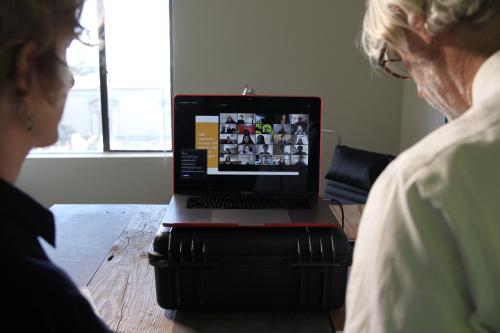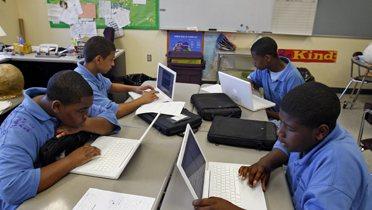Of the many things that are uncertain about how American higher education will look in fall 2020, one thing is not: Online learning is here to stay. That doesn’t mean that there will be no in-person instruction. Whether or not they are offering some in-person instruction, colleges will need to enable students to participate remotely. This is true despite the announcements by multiple colleges of plans to resume on-campus classes in the fall.
Why? Because splashy “we’re going to re-open!” announcements by some institutions notwithstanding, many—if not most—colleges will decide to keep all of their fall 2020 instruction online. And even for those that do manage to welcome students back to campus, new social distancing rules will greatly reduce classroom capacity. Since classroom space was at a premium even before the pandemic, once social distancing constraints are in place there is simply no way to deliver in-person instruction to all students. In addition, some students will be unwilling or unable to return to campus. The upshot is that for the foreseeable future the old way of doing business—in which colleges could tell students that they are required to be physically present on campus and in the classroom—isn’t coming back any time soon.
As a result, in fall 2020 and likely well beyond, there will be two categories of courses: 1) courses in which some of the students are in a classroom and others are online, and 2) courses offered exclusively online. Both formats raise major challenges for the higher education ecosystem.
The Challenges of a Mixed Online/In-person Class
A mix of in-person and online participation creates significant impediments. While it is certainly possible to optimize teaching for in-person participation, and also possible to optimize teaching for online delivery, it’s not possible to optimize for both simultaneously. When interacting with students in person in a classroom, an instructor can leverage a whole roster of communication techniques that are simply unavailable online. These include making eye contact with individual students, observing facial expressions and body language and adjusting the pace of the class accordingly.
A useful analogy can be found in the challenges that occur in a business meeting when some of the participants are sitting at a conference table and others are on the phone. Relative to the people in the room, the remote participants are at a substantial disadvantage when it comes to engagement. This is why, in the pre-pandemic world, people were so willing to incur the time and expense of traveling to far-away cities to attend important business meetings.
A course with a mix of in-person and online participants provides better learning opportunities to the students in the classroom as opposed to those participating from afar. Should instructors try to minimize this difference even though that would mean delivering a less-than-optimal experience for the in-person students? Or should instructors deliver the best in-person class they can, even though that inevitably disadvantages the remote students? There’s no easy answer.
The Disadvantages of Online Instruction
Many classes will be delivered purely online. In that case, instructors can optimize their teaching for online delivery. But online instruction, even when provided by a committed and knowledgeable instructor skilled in the tools of remote teaching, simply isn’t as good. As I explained in a Los Angeles Times op-ed back in 2011:
“A good lecture or seminar has its foundation in words but gains its texture and flow from countless other subtle cues and interactions in the classroom. These include the body language of the students that an alert instructor will observe and use in modulating the pace and content of the discussion, the pauses and inflections in student questions that would escape capture by a microphone, and the dynamism that occurs because each student, sitting among different neighbors at a unique location in the room, experiences and engages with the class slightly differently.
A course is also made effective by the unscripted interactions that occur as students gather before and after the class, and by the simple fact that the physical act of getting to class requires at least some investment of time and energy. In short, attending a well-run class in person is immersive and engaging in a way that far exceeds anything that consumer technology can possibly hope to deliver now or in the foreseeable future.”
The many college students who found it more difficult to focus on their classes after the March 2020 transition to online learning aren’t being lazy; they are simply being human. A class experience confined to a laptop screen doesn’t only involve physical separation; it also imposes a psychological distance that makes it objectively harder to focus attention.
Will Colleges Rethink Tuition Models?
Everyone—students, faculty, and college administrators—knows that a lot is lost when instruction is forced out of the classroom and onto Zoom. Yet colleges, at least for now, appear to be unwilling to reduce tuition accordingly. The Office of the President of the 10-campus University of California system (which includes UCLA, where I teach) recently added a note to its web site explaining that “Some or all instruction for all or part of Academic Year 2020-21 may be delivered remotely. Tuition and mandatory fees have been set regardless of the method of instruction and will not be refunded in the event instruction occurs remotely for any part of the Academic Year.” A mid-May Los Angeles Times headline stated “USC to raise tuition 3.5% whether classrooms reopen amid coronavirus shutdown or not.”
But colleges aren’t the only market actors. Student demand will drop as a result of what students rightly see as a less desirable educational experience. Most colleges (the exceptions are those where the pre-pandemic applicant demand greatly exceeded the supply of admissions spots) will need to adapt to avoid a downward enrollment spiral. One way to adapt is to reach greater numbers of students. For many courses, enrollment caps have traditionally been determined by the number of physical seats in a classroom. That limit no longer applies when some or all of the students in each course are online.
Of course, online instruction doesn’t mean there should be no class size limits at all, as opportunities for students to interact with instructors, teaching assistants, and their classmates will remain important. But for most courses, the enrollment could be expanded 10-20% without substantively impacting the student educational experience. When done at the scale of an entire institution, this would allow colleges to accommodate more students at a substantially lower per-student cost than occurs today. Those savings could be passed on to students in the form of reduced tuition.
Intercollegiate collaboration on teaching is another way for colleges to realize cost savings that could be passed on to students in the form of reduced tuition. When teaching is online, why limit students to courses offered by their own institutions? Exchange arrangements between institutions with similar academic calendars could allow unfilled virtual seats in classes at one college to be given to students at another college.
More broadly, the pandemic has made access to online instruction a core aspect of higher education. Along with the many resulting challenges, there are opportunities to make college both more widely accessible and more affordable.
The Brookings Institution is committed to quality, independence, and impact.
We are supported by a diverse array of funders. In line with our values and policies, each Brookings publication represents the sole views of its author(s).











Commentary
Online college classes are here to stay. What does that mean for higher education?
June 1, 2020